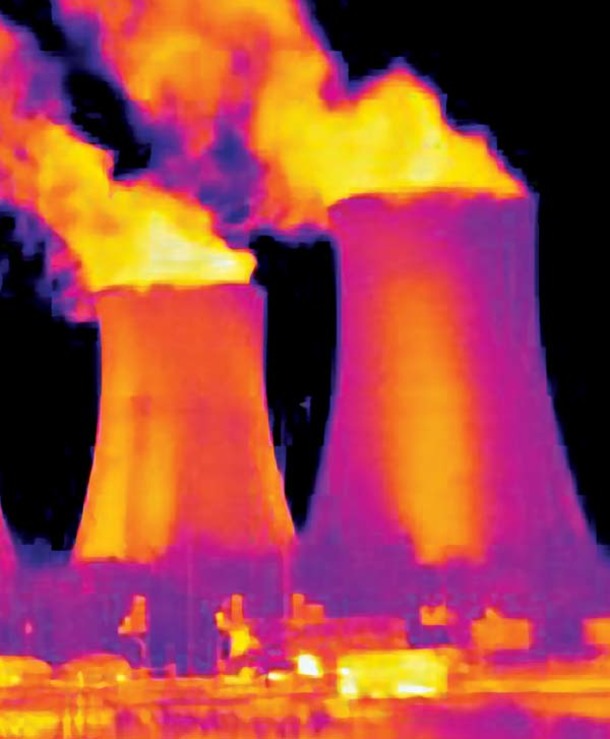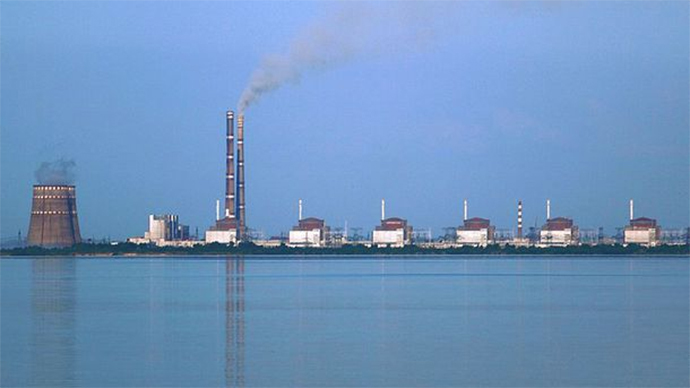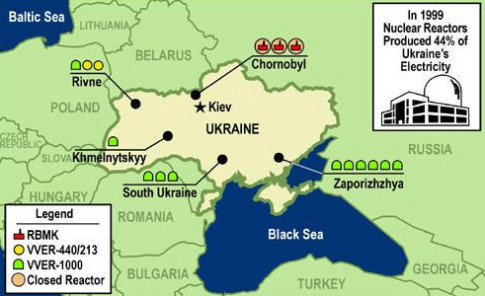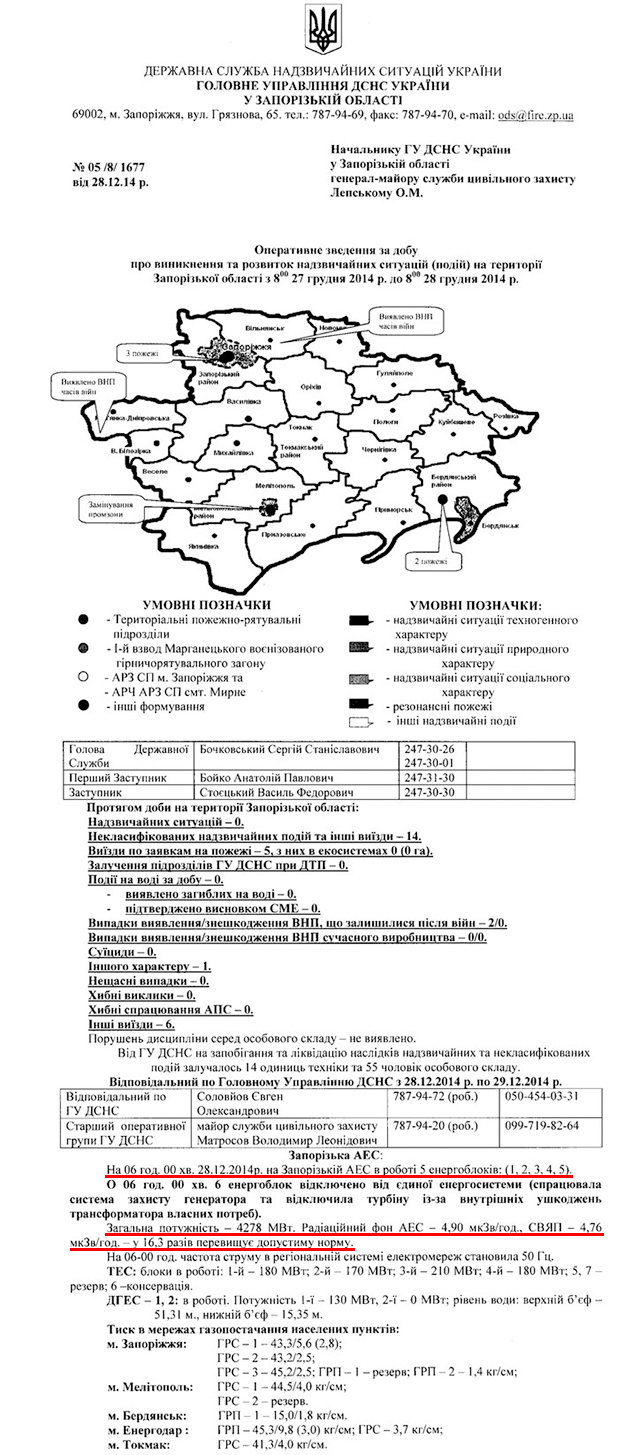– Is Ukraine Hiding A Huge Radiation Leak At The Largest Nuclear Power Plant In Europe? (ZeroHedge, Dec 30, 2014):
Two days ago we reported of the odd coincidence of a 2nd emergency shutdown at Ukraine’s Zaporozhye Nuclear reactor – Europe’s largest nuclear power plant – following our earlier fears of disinformation. Today, we get information of a leaked report sourced from three different place – unconfirmed for now (but RT is trying to verify) – that Ukrainian nuclear scioentists misled the public and a radioactive leak has been detected – citing the country’s emergency services claiming that levels of radiation are 16.3 times the legally permitted norm.
A radioactive leak has been detected at Ukraine’s Zaporizhia Nuclear Power Plant, the largest in Europe, a media report says, citing the country’s emergency services. The report claims that levels of radiation are 16 times the legally permitted norm.
LifeNews published a leaked report by the State Emergency Service of Ukraine, which denies an earlier assessment by the plant’s authorities that the radiation at the facility is equal to the natural background following an incident on Sunday.
RT is trying to verify the report.
On Sunday, one reactor at the plant was automatically shut down after a glitch, becoming the second halt in operations in recent weeks. The reactor was running at 40 percent of nominal power, the plant’s official website said, adding that radiation at the facility being at the level of 8-12 microroentgens an hour.
The error was later announced to have been corrected, and the troubled unit – Power Block # 6 – was plugged back into the network.
On November 28, Zaporizhia’s Unit 3 was switched off for almost a week. The shutdown, which was reportedly caused by a short circuit, was made public five days later, when Ukrainian Prime Minister Arseny Yatsenyuk revealed it during the first meeting of his new Cabinet.
* * *
Zaporizhia nuclear power plant is one of the four nuclear power plants in the country, which together supply a large part of Ukraine’s energy needs. The Zaporizhia plant alone, Europe’s largest, supplies at least one-fifth of the country’s power needs. It is the world’s fifth-largest nuclear power plant.
Ukrainian nuclear scientists misinformed the public and the media about the real state of affairs in the Zaporizhzhya NPP. The Internet got a summary of the State Service for Emergency Situations of the 28 and 29 December, which refute the assurances leadership Zaporizhzhya that the sixth unit was put into operation in the evening on 28 December. In addition, the permissible level of radiation at the plant, according to the measurements, was above the norm by 16 times.
Both documents addressed to the Chief of State GSCHS Ukraine in Zaporozhye region – Major General Civil Protection Lepsky. In summary for December 28, reported that at six o’clock in the Zaporizhzhya NPP due to damage to the transformer emergency generator protection system worked 6th unit.
– At 6 am on December 28 at the Zaporozhye NPP operates five units (1,2,3,4,5) … The total capacity of 4278 MW nuclear power plant radiation background – 4.90 mSv / year., SVYAP – 4.76 mSv / year . – 16.3 times higher than the acceptable norm – said in a bulletin.
Recall that the press service of the Zaporizhzhya NPP and representatives of “Energoatom” in the afternoon on December 28 reported an emergency situation, noting that the background radiation in a sanitary zone around the plant remains normal. After that, the head of the Ministry of Energy of Ukraine Dmytro Demchishin stated that repair of power will take a few days.
However, on the evening of December 28 the press service of Zaporizhzhya reported the completion of repair work and emergency unit is connected to the grid.
– December 28 2014 in 22 hours 35 minutes unit number 6 Zaporizhzhya after the fault is connected to the network. Being a set of power … – said in a statement on the official website of the plant. There’s also noted that the background radiation in the vicinity of the station corresponds to the natural.
However GSCHS summary for December 29, completely refuted this statement nuclear scientists. The document says that by 6 am Monday emergency sixth unit is not connected, the total capacity remained at the level of the previous day, and the radiation level in the vicinity of nuclear power plants and the storage of radioactive materials (SVYAP) increased.
– At 6 am on December 29 at the Zaporizhzhya NPP in five units (1,2,3,4,5) … At 6 am on December 28 sixth unit is disconnected from the unified energy system … The total capacity of 4278 MW nuclear power plant radiation background – 5.05 mSv / yr., SVYAP – 4.91 mSv / year. – Exceeding 16.8 times – said GSCHS Ukraine.
Recall first of background radiation above the threshold of 14 times in the area of ??Zaporozhye NPP evening of December 28 said the deputy chairman of the People’s Council DNI Dennis Pushilin. He explained leak Ukrainian nuclear scientists attempt to install power rod blocks produced by the American company Westinghouse.
* * *
Of course, there is no way to actually know what is happening on the ground as the NPP is located close enough to the “fog of war”, that its status, and updates thereof, could merely be part of the fog of war. That said, if there is an unspoken message here by Ukraine, which recently handed over its gold to unknown “Western” interests, and suddenly feels neglected by its western allies (as its central bank head is about to find out personally), it is targeted directly at the IMF: “hand over more loans, or the nuclear power plant gets it.”
However, this appears more serious than simple false flags.
Curiously, all this takes place at a peculiar time: just as Ukraine announces it is replacing its nuclear fuel supplier from Russia to US conglomerate Westinghouse:
Ukraine on Tuesday sealed an additional nuclear fuel supply deal with US giant Westinghouse in order to ease its energy dependence on Russia.
Westinghouse Electric Company said it signed a deal in Brussels with Ukraine’s Energoatom state nuclear power provider “to significantly increase fuel deliveries to Ukrainian nuclear power plants through 2020.”
No figures were immediately available for the value of a deal which Ukrainian Prime Minister Arseniy Yatsenyuk had said would take place.
Nor were there details on the quantities of fuel or number of reactors involved. The two sides had earlier this year extended their existing cooperation agreement through 2020.
A top Energoatom official said this month that Kiev would like to purchase additional Westinghouse nuclear fuel for 13 of its reactors.
US-based Westinghouse currently supplies fuel for only one of Ukraine’s 15 operating units — the third reactor of the South Ukranian Nuclear Power Plant that is located 300 kilometres (185 miles) south of Kiev.
Ukranian media said Energoatom and the US firm had been cooperating on nuclear fuel supplies since 2000.
The former Soviet republic had previously relied on Russian nuclear fuel manufacturer TVEL.
And, most coincidentally of all, just as the news was developing, the Russian Ministrey of Foreign Affairs tweets this:
By replacing #Russia with #US supplier of nuclear fuel, #Ukraine endangers health of its citizens, peoples in #Europe http://t.co/YqeVgYT6lM
— MFA Russia (@mfa_russia) December 30, 2014
Just one too many coincidences in a row?
H/t reader squodgy:
“Am I alone in recalling the spat over the compatibility between Westinghouse Rods and the Russian rods for which Ukraine’s reactors were designed?
The Russians foretold possible problems if U.S. rods were just inserted willy-nilly.
Looks like they were right.http://www.kyivpost.com/content/ukraine/fuel-duel-326535.html“

Steam rises from two nuclear power plant cooling towers in this thermal image. A battle between Russia and the U.S. is being waged in Ukraine to supply the country with nuclear fuel.
– Fuel Duel (Kyiv Post, July 4, 2013):
A fight over the supply of nuclear fuel sounds like something from a futuristic sci-fi novel. But that is exactly what is unfolding here in Ukraine, as a Russian and an American company clash over the control of a market worth more than half a billion dollars per year.
About half of Ukraine’s electricity is produced by nuclear power plants. Russia, the long-time monopoly supplier of nuclear fuel to Ukraine, was met with a challenger in 2011, when the American Westinghouse Electric Company got its foot in the door. It was contracted by state nuclear energy company Energoatom to provide fuel to three of the country’s 15 reactors over five years in a deal experts say is worth more than $100 million.
But Westinghouse hit a roadblock in 2012. During a scheduled maintenance at the Yuzhnoukrainsk nuclear power plant, located some 350 kilometers south of Kyiv, Ukraine’s State Inspectorate for Nuclear Regulation found that Westinghouse’s fuel assemblies (cases that support nuclear rods in the reactor) were damaged and unsuitable for future use.
Although the Americans took the brunt of public bashing for the flaw, Michael Kirst, Westinghouse vice president of customer relations and sales in the region, says that the problems lie with the design of fuel assemblies produced by its Russian competitor, the state-owned nuclear fuel maker TVEL, which has long held a monopoly in the Ukrainian fuel market.
Russian-made fuel assemblies are used alongside the American ones in three of Ukraine’s reactors. Using a variety of suppliers is new for Ukraine, but it is common in most other countries that produce nuclear energy.
Westinghouse first brought fuel to test in Ukraine’s Yuzhnoukrainsk reactor No. 3 in 2005. It worked as designed, according to the company, and at the time TVEL’s assemblies were similar to Westinghouse’s, allowing the two to operate seamlessly in Ukraine’s reactors.
But shortly thereafter, Kirst said, TVEL changed its fuel assembly design, which did not fit well in Ukraine’s reactors alongside those made by Westinghouse. He said the move was likely done to spite Westinghouse.
“Russia is doing everything to make it difficult for us (to operate in Ukraine),” he told the Kyiv Post.
In a written response to the Kyiv Post, TVEL deflected the accusation. “The process of improving the characteristics of Russian nuclear fuel does not align with our desire to somehow complicate someone’s life,” the company said. Ukraine’s Energoatom provided no comment for the story.
Yet Kirst insists that his company’s fuel assemblies “are being damaged because the Russian (TVEL) fuel is bending substantially” and colliding with other assemblies inside the reactor. “Westinghouse designs performed perfectly,” he said.
The technical term used in the industry to describe the bending is “fuel bow,” a certain amount of which is necessary.
“The fuel assembly should be flexible, but not bending in the manner in which TVEL’s are,” Kirst explained. “If you look at a photograph of (the TVEL fuel assembly), you’ll see the space between is so narrow that (Westinghouse) must force its fuel assemblies into the reactor. I don’t have to tell you that (with nuclear fuel assemblies) that is a bad idea. These things can’t be forced.”
Olga Kosharnaya, a leading researcher of energy security at the government-funded National Institute for Strategic Studies in Ukraine, says problems with Russian-made fuel are actually common. In 2011 alone, 21 TVEL assemblies were discovered to be defective in Ukraine, she said.
The problems caused by this design flaw included the depressurization of fuel elements, which led to the release of radioactive contaminants in some cases, she said.
But TVEL insists that its “fuel element for many years has successfully, safely and reliably operated at power plants in Ukraine, and has received no complaints and criticism from Energoatom and by the Ukrainian regulator.”
But it was Westinghouse that was asked by the State Inspectorate for Nuclear Regulation to improve the design of its assemblies to ensure further delivery of its fuel to Energoatom’s nuclear power plants.
Another agency, the State Financial Inspection of Ukraine, said the American-made fuel assemblies are flawed and have cost Energoatom Hr 114 million (about $14 million). Energoatom officials on June 13 said they were preparing a lawsuit against Westinghouse in case it did not remedy the issue, according to an Interfax-Ukraine report.
At the end of June the Americans submitted a proposal to the State Inspectorate for Nuclear Regulation for improving the design of its fuel assemblies to be able to continue supplying fuel along with TVEL. But even if the proposals are accepted, Westinghouse won’t be out of the woods yet.
Ildar Gazizullin, an energy policy specialist and economic analyst at the Ukrainian Institute for Public Policy, says that he has seen “a lot of disinformation and (misuse of facts) around this issue.”
“Russia is concerned with protecting its markets in Central Europe and has made attempts to keep competitors out,” he said.



Does it matter who made them? The US made the Fukushima plant.
The point is the result…..is this plant going to be able to be shut down safely……unlike Fukushima? Or, do we have another nuclear disaster in the Ukraine?
Who cares who made them? US or Russian, what difference does it make?
The results are what matter.